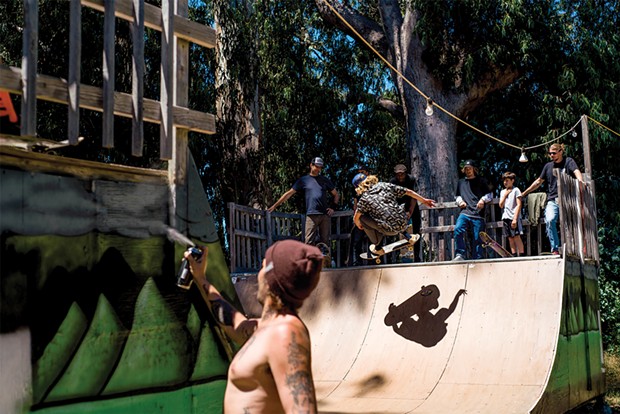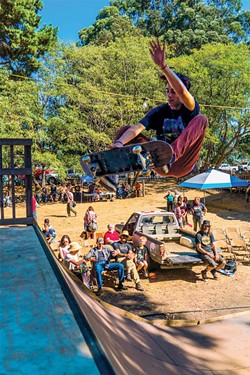[
{
"name": "Top Stories Video Pair",
"insertPoint": "7",
"component": "17087298",
"parentWrapperClass": "fdn-ads-inline-content-block",
"requiredCountToDisplay": "1"
}
]
Driving the Lost Coast through the spot on the map that is Petrolia, it is hard to miss the community skate ramp. Perched in a field adjacent to the Mattole Valley Community Center, it is one of only a scattering of landmarks dotting the rural landscape. As a former resident of Petrolia, I've witnessed faces marveling at the sight as they drove by. "Who on Earth uses that ramp in the middle of nowhere?" they seemed to wonder. The answer is: everyone. In Petrolia, the Mattole Half Pipe is a heart of the community, a gathering place for young and old — not just skateboarders. Toddlers crawl and run on the ramp, then turn into teenagers giggling and whispering with their legs dangling over the coping. Adult musicians perform to hoots and hollers on the ramp as a stage. It is a hub of community life in a tiny hamlet.
A lifelong skater, Dave Grant moved to Petrolia in 1996 and shortly thereafter began taking his two young boys skateboarding at the Mattole School campus. Without many safe havens for play, other kids soon joined them. The informal gatherings grew until school authorities got nervous. Skateboarding on campus was a liability. So the skaters ventured to the streets, skating along the road near the general store instead. Concern for the children's safety mounted. One local parent in particular took the helm in rectifying the issue. Bev Haywood's idea was to form a 4-H skating club, which could give the kids legal status to be allowed on campus. "If it wasn't for Bev, there would be no ramp. There would have been no skateboarding club. None of this would have happened," says Grant.
It was 1998 and only one other place in the nation had a 4-H skate club: Bozeman, Montana. Fueled by Haywood, the 4-H application for the Mattole Sk8 Club was accepted. Grant, Haywood and others persuaded the school board to allow this new club to meet on school grounds. Eventually, the board consented with the caveat that all skaters wear helmets. "The sign for helmets is still there, outside the school. I bet it is the only one of its kind around," said Grant. "How many schools grant access to skateboarding?"
Excitement for the club escalated. About 12 kids joined up, a significant number in a place with fewer than 800 residents according to the 2000 census. The school allowed the kids to bring launch ramps to campus and eventually gave them a shed to stash their equipment. As skateboarding became more mainstream, the club's activities evolved. The idea for the actual skate ramp, though, belonged to Triple Junction High School student Adam Neil.
Neil wanted to design a skate ramp for his high school mentor project with Grant as his mentor. Grant knew exactly what they should draw: a half pipe just like the one he had built as a kid, only slightly larger. It was Haywood, however, who would bring the ramp into reality once the drawing was complete. "My interest wasn't really in skateboarding," Haywood said. "It was in keeping the kids safe ... in giving them a place to belong and gather." She helped Neil and Darian Smith write a summer youth grant proposal for the Humboldt Area Foundation, which they received, and organized an ice cream parlor out of the Mattole Valley Community Center to raise matching funds.
"One day, this guy in a cowboy hat walked in and stopped at my information table to talk about the ramp. He said his kids skateboard and he was interested in helping out," said Haywood. Instead of buying ice cream, the man — Chris Berry, owner of Shamus T. Bones — cut them a sizable check.
"People kicked in and donated," said Grant. "We were able to get this expensive Skatelite surfacing for the ramp. I think that is why it has survived as long as it has. I have never seen an outdoor ramp last longer than five, maybe 10 years at best." After the money had been collected and materials ordered, people came out of the woodwork to help. With the community pulling together, the ramp was built in a total of three days.
That was 2000. Now, 21 years later, the Mattole Half Pipe is still going strong thanks to Grant and the community support in maintaining it. That includes funds collected via its GoFundMe account, which gathers donations for upkeep and insurance. And folks are still stoked to skate out in the middle of nowhere.
Tamar Burris (she/her) is many things, including a former resident of Petrolia. She is also a freelance education writer and relationship coach. Her book for children of divorce A New Special Friend is available through her website www.tamarburris.com.
more from the author
-
The Reluctantly Famous Shoshoni Hostler
- Feb 15, 2024
-
The Future is Now
Backcountry Metaverse at the Brenda Tuxford Gallery
- Sep 21, 2023
-
The Return of '30,000 Salmon'
Becky Evans' collaborative installation at the Morris Graves
- Aug 17, 2023
- More »
Latest in Get Out
Readers also liked…
-
A Walk Among the Spotted Owls
- Apr 27, 2023

































